Interview
Unravelling Histories: The Poetic Structures Of Gerry Judah
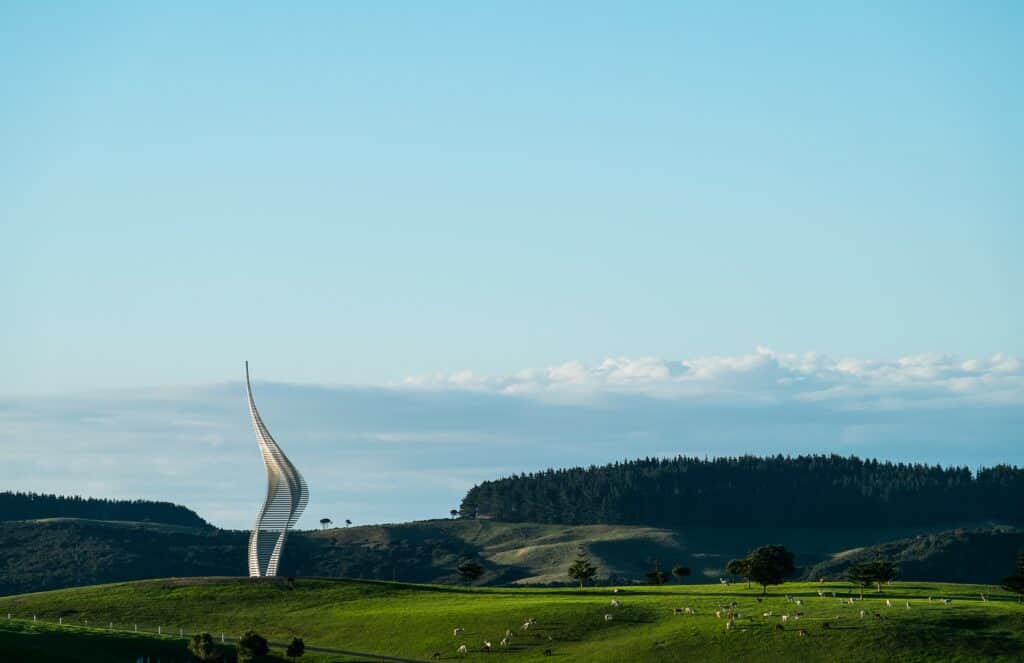
By Adam Hencz
“It’s always a process of discovery, often taking me where I have never been before.”
Gerry Judah
A vigorous designer, artist and creator, Gerry Judah is constantly adding new pieces to his stunningly diverse oeuvre, from airy oil pastel drawings, through three-dimensional paintings commenting on war and conflict, to iconic structures soaring over dozens of metres into the sky, furthering his visual language by each day.
After graduating from Goldsmiths College and Slade School of Fine Art in the ‘70s, Judah worked on settings in some of the UK’s leading theatres and began to build a reputation for innovative design working in film and television as well, while shifting settings for his own art from show business towards more public arenas like museums, galleries and vast open spaces. His monumental sculptures are on display across the globe, responding to various landscapes and spaces such as the St Paul’s Cathedral in London, the Gibbs Farm Sculpture Park in New Zealand or the House of Wisdom in the Emirates.
The British artists’ recently completed striking body of work BENGAL, built over nearly a decade, engages with environmental issues of his childhood home and at the same time reflects on his personal roots and memories of growing up in Kolkata. Artland had the pleasure to sit with Gerry Judah, and be taken on a journey through razed cities and delicate sculptures, and talk with the artist about spirituality and the joy of discovery.
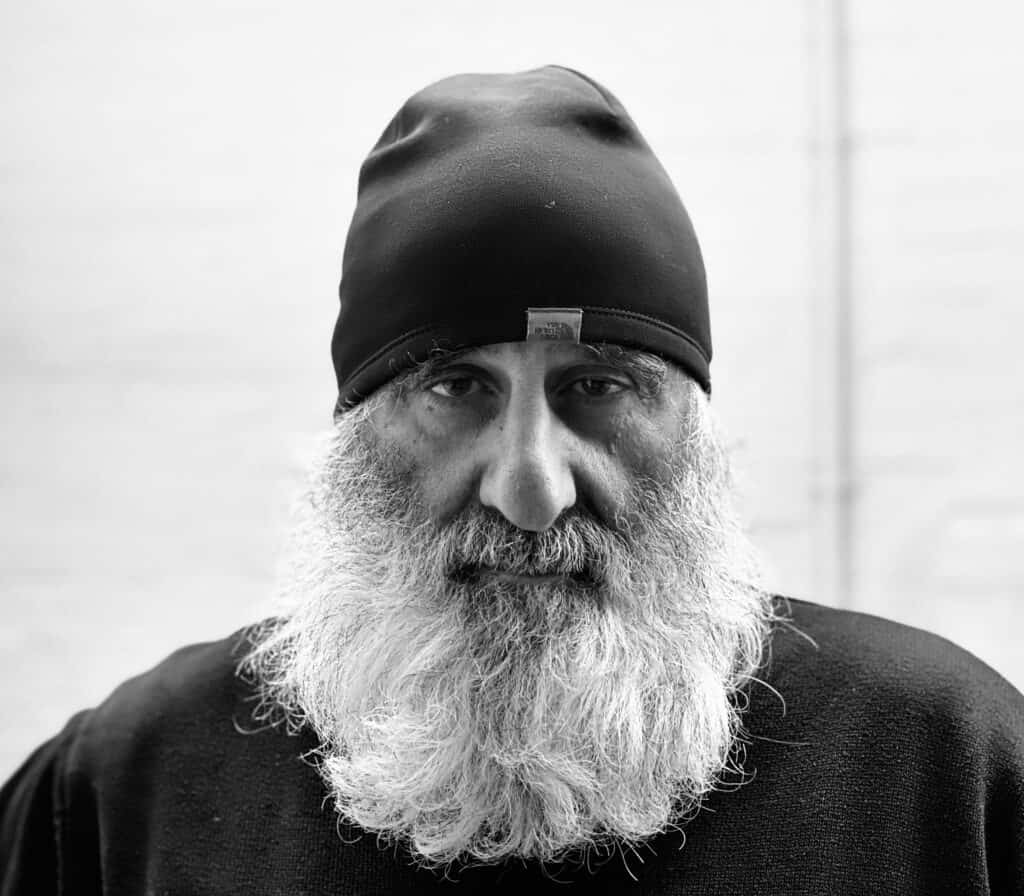
Drawing is at the very core of your practice and it plays an important part in developing ideas for other works, especially for sculptures. Could you describe what role drawing has in your practice?
Drawing is indeed a very big part of my practice. I’ve been drawing voraciously since I was a little boy. Even on the bus or train, I would draw numerous ideas on my tickets. To this day, I’m constantly drawing, whether it’s with massive black oil sticks or pastels at my drawing board or little sketches in front of the television. Drawing defines me as an artist. A lot of my BENGAL pieces constructed out of bits of wood are for me, 3D drawings. They are often not predetermined sculptures or artworks though I have in mind what I’m aiming for. I like to however move in different directions, to experiment. It’s always a process of discovery, often taking me where I have never been before.
Your most recent solo exhibition at Encounter Contemporary displayed pieces from your BENGAL series, a body of work spanning almost a decade now. It engages with issues of climate change and reflects on profound changes in India’s social fabric simultaneously exploring your own personal history. As part of a commissioned project from the Arts Council and Christian Aid, you returned to Kolkata, to your childhood home. What did that trip to India mean to you and how did it affect you as an Artist?
The Arts Council commissioned artists like John Keane and Don McCullin, to visit Christian Aid’s outreach projects, for example in the Middle East and Africa, and produce artworks reflecting on their trip. In my case, it was the urban sprawl of Kolkata, where I was born and grew up for my first ten years, and the farms of Bengal. Returning after fifty years was extraordinary. We visited many rural communities, such as the Dalits (people belonging to the lowest caste in India, characterised as “Untouchables”) where the depleting rivers caused them to keep relocating their homes, and the miles of Mangroves to dry up. We saw how they were living under the enormous duress the impact of climate change had on them. After all those years for me; the energy, the heat, the light, the smell, the sensibilities were all still there. But it was quite a shock at the same time, that helped me think differently. “How do I depict this?” “Do I make copies of exactly what I saw, or take the essence of what I experienced and turn it into an artwork in its own right?” The emergent pieces for me were quite simple, almost like lines of poetry. Not trying to say too much. Though there was a lot of environmental damage, pollution, poverty, I avoided my work as reportage and pontification. I also needed to express my personal history, experience and spiritual path. Growing up in India in the already established Baghdadi Jewish community at the same time absorbing the cultures of Hinduism, Islam, and Buddhism had a profound effect on me. All those amazing festivals, rituals. It was all there, all over the city, in the streets; theatre in the round. I tried to put that into the work.
You had a great interest in Jungian theory and the Collective Unconscious at the beginning of your career, especially for the creation of Succah in 1977. You have also been embracing religious references and contexts for your past works. Is Art a spiritual occupation for you?
As a child, I spent a lot of time with my father and the elders in the temple. Those old men sitting there, praying, praying, praying. Though I felt connected being in this beautiful space, that intensity of prayer was something I somehow could never connect to, much as I tried. It was a bit like being told what to read, what to believe, how to worship. But what I did like was the Ark at one end. It was the focus, the Stage that everybody looked upon containing the Holiest of Holys. Those sacred scrolls hidden behind the curtains then revealed with awe and delight. That itself was quite a spiritual experience for me, and that was what I wanted to thrive for. So Art has always been my form of prayer, my personal way forward. My very own spiritual and religious path. The creative process was my personal Talmud. My relationship to the past, the present and the future. As a consequence, like my avoiding religious dogma, the Succah was the result of my avoiding making Art but instead making something I felt intrinsically linked to, which inadvertently connected to age-old Mesopotamic Judaic structures, thus my subconscious having a very big role in my work.
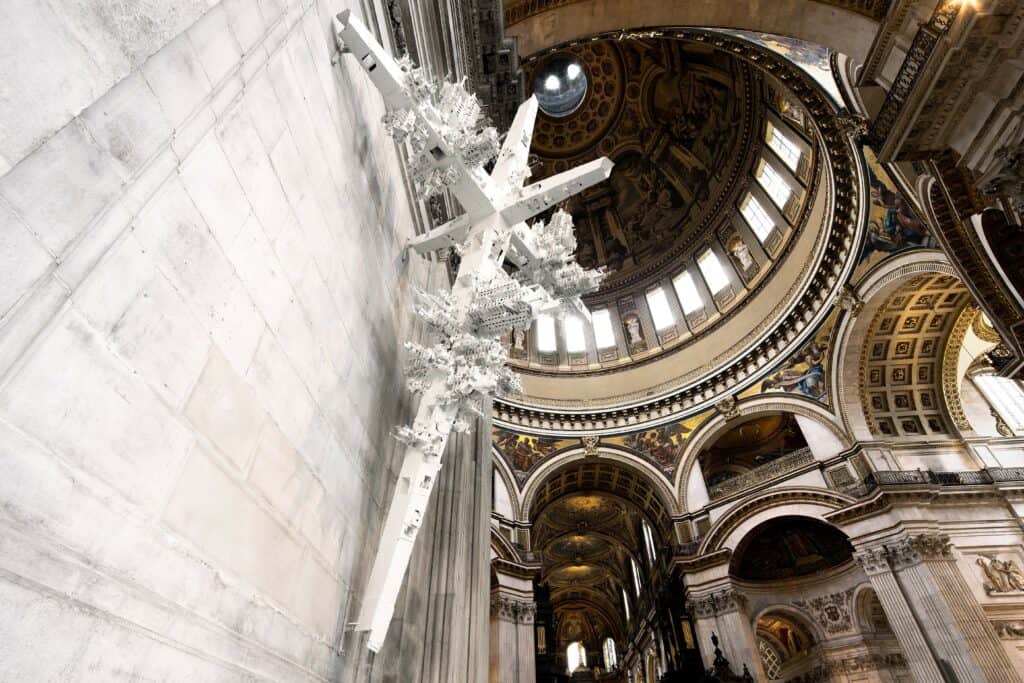
You returned to painting after a model making and set design business, and began creating a series of canvases that evolved from the Auschwitz-Birkenau installation you made for the Imperial War Museum’s Holocaust Exhibition. Three-dimensional paintings have been present in your practice since then, since FRONTIERS (2005), and throughout FRAGILE LANDS (2016) for example. What urged and motivated you to create 3D paintings?
The Auschwitz-Birkenau installation was a three-dimensional historic document and a miniature, but epic film set. It was to inform, but also to move you. Instead of using colour, we opted for white, to level out the story. All that transportation, movement and selection for slave labour or death throughout the day captured in one moment. As Hannah Arendt called “The Banality of Evil”. Like the images in the media of destroyed buildings through recent conflict in the Middle East and Eastern Europe, revealing the innards; rooms, stairs, lift shafts, furniture, all manner of detritus showing fragments of people’s lives cut short. And the levelling of white everywhere, caused by all that dust. Also living in ’60s and ’70s London, there were a lot of buildings in the state of demolition. Demolished walls everywhere. Large abstract paintings of people’s existence. Wallpaper, shelves, shadows of once were pictures, basins, bits and pieces, again all manner of detritus. Inadvertently through conflict, or environmental decay, or just social change, there was always an archaeological element to it.
Cities are very archaeological as they are layered, built and built upon, always something underneath something else. For my paintings, I made model buildings with all their details; walls, staircases, doorways, water towers, satellite dishes, aerials. I then smashed and ripped them apart on the canvases and painted white or black (red sometimes) acrylic gesso to embed and unify everything. Revelation through light. Beautification. Purification. Shimmer. Often I would destroy everything again, leaving the scarred remnants on the canvas and build yet another settlement on top, and destroy it all again. Some of these paintings have two or three layers of settlements within them. Crusted texture all over the place. They themselves are very archaeological and take a really long time to make. I have to be careful not to do it again otherwise it will never end. Leonardo da Vinci once said, “Art is never finished, only abandoned.”

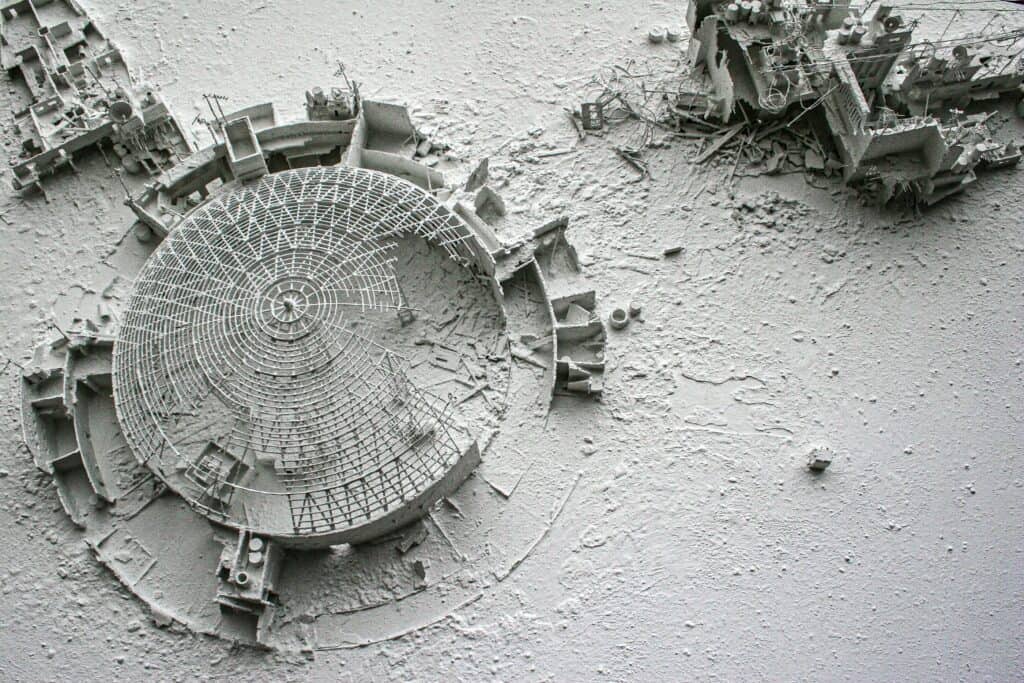
Once you said that “by building it and then ripping it down, it actually makes the ideas stronger than the actual things.” Where does this creative approach of yours stem from?
I would rather be surprised about how things turn out than arrive at a predestined result. But then again, I wouldn’t let it happen. My canvases are sort of performance pieces. Physical, dramatic, needing to play, to fool around, to discover something different. I rip through my little buildings to discover new shapes, new spaces. In New Cross, London in the ’70s, when I was at Goldsmiths College, there were a lot of abandoned empty houses nearby. I would enter these places, set up a video camera at one end and film myself peeling off the walls, floors, room by room, and then start to rip everything apart, just to see what was underneath. I loved the peeling back. I was also at the time, and still am, very taken with the work of Gordon Matta-Clark who cut these amazing shapes out of discarded buildings in New York in the ’70s. Very powerful! I love cities that are in a constant state of change, revealing the past as it moves forward. You see into and through everything as you go by. Amongst all of that, there’s always a strong sense of structure throughout.
“It was also my constant attempt on these monumental sculptures to achieve a lightness of touch, a simple stroke of a line that elevates you, like a piece of calligraphy.”
Gerry Judah
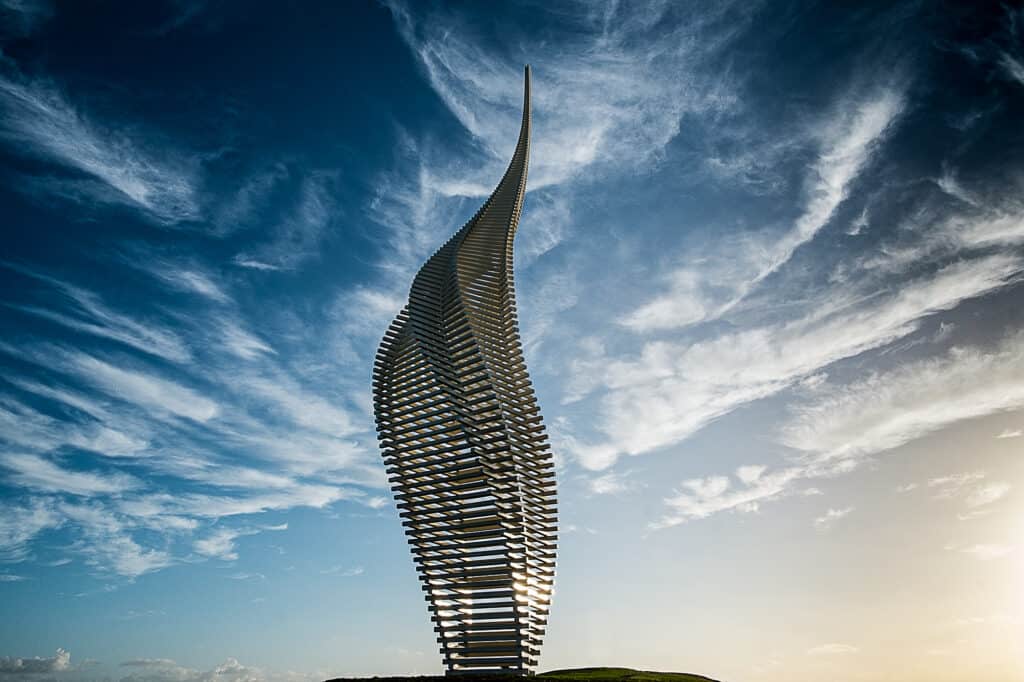
Some of your most recent large-scale works that are on permanent display are JACOB’S LADDER (2018) at Gibbs Farm Sculpture Park in New Zealand and THE SCROLL (2019) in the Emirates. Could you share your thoughts on how they connect to the surrounding landscape and place?
I am constantly developing ideas and working on new pieces. This benefits me a huge catalogue of ideas that I can apply to the right projects. For example, THE SCROLL which was created to sit by the House of Wisdom in Sharjah was originally designed to look like a flame. It was part of the “Four Elements” – Fire – which I also used as part of my BENGAL series. For the House of Wisdom, the brief was the celebration of reading and the power of books, and the shape also revealed itself as a scroll, an unravelling of paper that reached out to the sky. It was also my constant attempt on these monumental sculptures to achieve a lightness of touch, a simple stroke of a line that elevates you, like a piece of calligraphy. That’s where engineering comes in, the very hard work to achieve a level of simplicity. For JACOB’S LADDER, I again wanted a very pure shape, like a twist of smoke that stretches to the sky, but made up of massive steel beams twisting and turning to achieve the shape, to make it elegant and beautiful, and to look impossible and practical at the same time. It is always a challenge when you have to work with engineers because they want to make it safe and secure, and all you want to do is create something dangerous and insecure.
Once you mentioned that you would love to create the BENGAL sculptures in large scale as well. Where and how would you like to see them erected?
These sculptures came from the time when my visit to Kolkata was during the Hindu Durga Puja festival where they construct very large temporary structures called Pandals. These are edifices in many styles and finishes, with inner structures made out of bamboo. I actually preferred the intensity of thousands and thousands of bamboo sticks tied to each other to form these amazing structures before they were clad. It reminded me of making those theatre sets, all rough and ready behind the decorative finish. Though all my BENGAL pieces are in reduced scale, intricate as they are, I would quite like to make one or two much larger, like the Radhayatra Juggannath chariots, massive temples balanced precariously on wheels, moving from town to town. The concept is there, but in a larger scale, that would be something else!
What is your next commission or project that you are working on?
I’ve always considered myself a ‘project artist’. After leaving the Slade, I found work in the theatre, films and photography which gave me a number of different challenges in different media, all setting me up in all directions. So be it an abstract set for a ballet, a 50-metre high sculpture displaying cars, a model depicting the Holocaust, even a city made out of biscuits for a TV commercial, I enjoy different challenges. Currently, I’m designing and making the Ark for a new Synagogue. It is a fantastic commission because it’s where I can really play with form, light and theatre. All altars are theatrical and often face in one direction. They are the stage upon which rituals happen. This time, I am trying to harness the spirit of the community in the piece, bringing a more egalitarian aspect to it, rather than making it about my individual reflection. I am making it out of different materials; hardwood, copper and glass. I’m also working on a couple of public sculptures and of course, there’s always the paintings and drawings.
Relevant sources to learn more
See Gerry Judah’s works on his homepage or browse pieces available for purchase on Artland.
Gerry Judah: BENGAL at Encounter Contemporary.